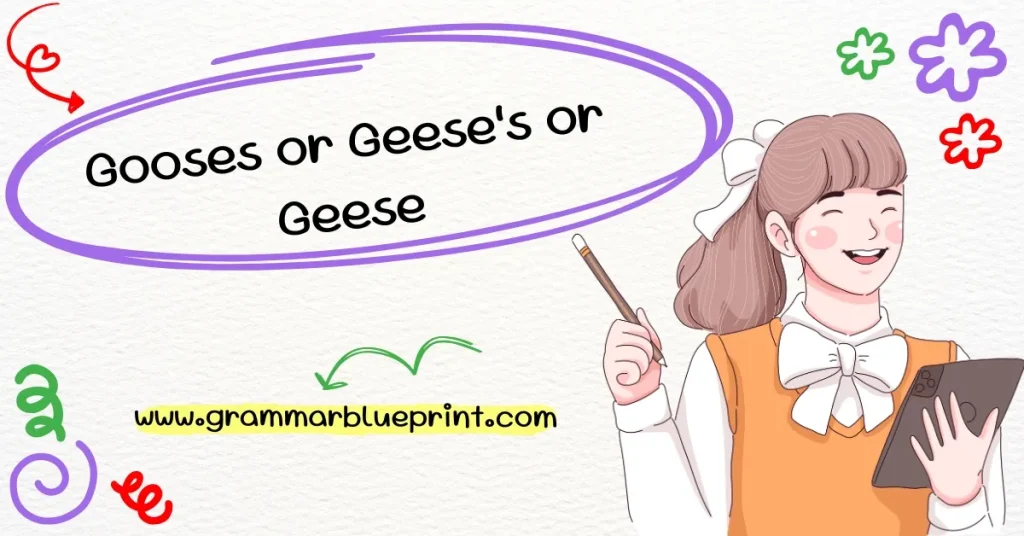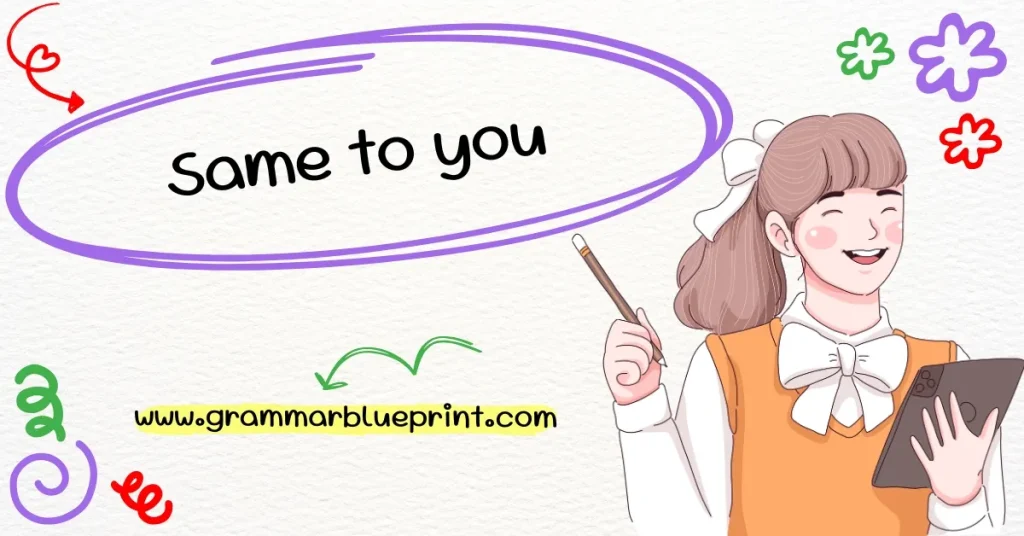If you’ve ever been unsure about whether to say “Gooses” or “Geese’s,” don’t worry—you’re not alone! It’s a common source of confusion for many learners of English. Understanding the difference between the plural “Geese” and the possessive form “Geese’s” is essential for clear communication. Let’s break it down in simple terms and clear up the confusion once and for all.
What is the Correct Plural of “Goose”?
Let’s start with the basics. The plural of the word “Goose” is “Geese”. That’s right! Instead of saying “Gooses” when talking about more than one goose, the correct term is “Geese.”
For example:
- Correct: “A flock of geese is flying south for the winter.”
- Incorrect: “A flock of gooses is flying south for the winter.”
It’s important to note that “Geese” is what we call an irregular plural. Unlike regular nouns, which simply add an “s” to form the plural (e.g., dog → dogs), some nouns, like “goose,” undergo a more dramatic change when pluralized.
Now, why isn’t it “Gooses”? Simply put, it’s not how the English language works for this word. There’s no need to add an “-es” at the end—“Geese” is the correct plural form, and that’s all there is to it!
Here’s another example:
- Correct: “There were two geese in the park.”
- Incorrect: “There were two gooses in the park.”
Understanding Possessive Nouns
Before we dive deeper into the possessive form, let’s make sure we understand what a possessive noun is. A possessive noun shows ownership or a relationship between one thing and another. In English, we usually form possessives by adding an apostrophe and sometimes an “s” to the noun.
For example:
- Regular noun: dog → Possessive: dog’s (the dog’s collar)
- Irregular noun: child → Possessive: child’s (the child’s toy)
The same rule applies to “Goose” when it comes to possession, but there’s a small twist when we talk about “Geese.”
How Possessives Are Formed in English
- Regular Nouns: Add an apostrophe and an “s.” Example: “cat” becomes “cat’s.”
- Irregular Nouns: Often, only an apostrophe is added. Example: “children” becomes “children’s.”
Now that we have a basic understanding of possessive nouns, let’s move on to the real heart of the confusion: Geese’s vs. Geese. Stay tuned for the next section!
Is It “Geese’s” or “Geese”?
Alright, now that we’ve got the plural form of “Goose” down, let’s address the main confusion. Should you use “Geese’s” or just “Geese”? The answer depends on what you’re trying to express—whether it’s plural or possessive.
The Difference Between Plural and Possessive
- “Geese” is the plural form. It refers to more than one goose.
- Example: “I saw a group of geese near the lake.”
- Example: “I saw a group of geese near the lake.”
- “Geese’s” is the possessive form. It shows that something belongs to the geese, or relates to them.
- Example: “The geese’s feathers are incredibly soft.”
- Example: “The geese’s feathers are incredibly soft.”
Notice the difference? The plural “Geese” simply tells us there are multiple geese, while “Geese’s” tells us something belongs to those geese.
When and How to Use “Geese’s” as the Possessive Form
If you’re talking about something that belongs to the geese (for example, their feathers or their habitat), then you use “Geese’s” with the apostrophe and an “s.”
- Correct: “The geese’s honking woke me up at dawn.”
- Incorrect: “The geese honking woke me up at dawn.”
In this case, “geese’s” shows that the honking belongs to the geese.
Why “Geese” is Used for Plural, Not Possessive
Many people mistakenly add an apostrophe to the plural form, thinking it’s needed to make it possessive, but this isn’t the case with irregular plurals like Geese.
If you just want to refer to more than one goose, don’t add an apostrophe—just stick with “Geese.”
Common Mistakes with “Gooses” and “Geese’s”
Okay, now let’s talk about the typical mistakes learners often make with these words. The two most common errors are:
- Using “Gooses” instead of “Geese”: As mentioned earlier, “Gooses” is incorrect. The plural of “Goose” is always “Geese,” never “Gooses.”
- Using “Geese’s” when you just mean plural: When you’re talking about more than one goose, you should simply use “Geese”—no apostrophe needed.
These mistakes happen because many learners confuse regular plural forms with irregular ones. So, just remember: “Geese” is always the plural, and “Geese’s” shows possession.
How to Avoid These Mistakes
- Tip 1: Remember that “Geese” is an irregular plural, so it doesn’t follow the typical “-s” rule.
- Tip 2: Only add an apostrophe to make “Geese’s” when you’re showing possession (something belongs to the geese).
How to Use “Geese” Correctly in Sentences
Now that we’ve cleared up the confusion between “Gooses” and “Geese’s,” let’s explore how to use “Geese” correctly in sentences. Whether you’re talking about more than one goose or describing something that belongs to the geese, understanding how to construct your sentences is key.
Proper Usage of “Geese” in Plural Form
When referring to more than one goose, always use “Geese” to express the plural form. Here are some examples of how to use “Geese” in sentences:
- Correct: “There were several geese swimming in the pond.”
- Correct: “Geese are often seen migrating in the fall.”
- Incorrect: “I saw two gooses at the park.”
Notice how we don’t use “Gooses” at all in these examples. Just stick to “Geese” for the plural!
How to Form Sentences with “Geese”
When using “Geese” in a sentence, the structure is simple. Just follow the typical subject-verb agreement rules. For example:
- Subject: “The geese”
- Verb: “are flying”
- Object: “over the lake.”
So, a sentence could look like: “The geese are flying south for the winter.”
This keeps it clean, straightforward, and grammatically correct!
When to Use “Geese’s” in Context
Now, let’s talk about “Geese’s”—the possessive form. You’ll use “Geese’s” when you’re talking about something that belongs to the geese.
For example:
- Correct: “The geese’s feathers were shining in the morning sunlight.”
- Incorrect: “The geese feathers were shining in the morning sunlight.”
In the correct example, “geese’s” shows that the feathers belong to the geese. It’s essential to remember that only the possessive form gets the apostrophe!
Here’s another example:
- Correct: “I admired the geese’s migration patterns.”
- Incorrect: “I admired the geese migration patterns.”
Again, the possessive “geese’s” is used to show ownership of the migration patterns.
Why “Gooses” is Incorrect and How to Remember the Right Form
You might be wondering, “Why is ‘Gooses’ wrong?” Well, “Gooses” is incorrect because English has irregular plurals. As we’ve established, “Geese” is the correct plural form of “Goose”, and “Geese’s” is the possessive form.
Here’s a simple tip to help you remember:
- If you’re talking about more than one goose, just say “Geese” (no apostrophe).
- If something belongs to the geese, then use “Geese’s” (with the apostrophe).
Tips for Non-Native English Learners
Non-native speakers often face challenges with plural and possessive forms in English, especially when dealing with irregular plurals like “Geese.” Here are some tips to help you:
- Listen to native speakers: Pay attention to how native speakers use these words. Practice mimicking their speech to get a feel for the proper usage.
- Use flashcards: Write down examples of “Geese” and “Geese’s” on flashcards to help solidify the difference in your mind.
- Practice in sentences: Try creating sentences with “Geese” and “Geese’s” to get comfortable with their usage. The more you practice, the easier it will become!
Conclusion
To wrap things up, let’s recap the key points we’ve covered about “Geese,” “Gooses,” and “Geese’s”:
- “Geese” is the plural form of “Goose.” It refers to more than one goose and is the correct term to use when discussing a group of these birds.
- “Geese’s” is the possessive form, meaning something belongs to the geese (for example, their feathers or their migration patterns).
- “Gooses” is incorrect, so just stick to “Geese” for the plural and “Geese’s” for the possessive.
Encouragement for Learners
Now that you have a better understanding of these tricky words, I encourage you to practice using them in your own sentences. Whether you’re writing, speaking, or just practicing in your head, the more you use these forms, the more natural it will feel.
Remember: English grammar can be tricky, but with some practice and attention to detail, you’ll start using these forms correctly without a second thought. Keep practicing, and don’t be afraid to make mistakes—that’s how you learn and improve!
Final Tips on Improving Fluency
- Read and listen to a variety of English content—books, podcasts, and even social media. Pay attention to how words like “Geese” and “Geese’s” are used.
- Practice, practice, practice! The more you engage with the language, the more fluent you’ll become in recognizing and using plural and possessive forms.
English grammar doesn’t have to be overwhelming. With a little patience and consistent practice, you’ll master even the trickiest parts. Happy learning!



